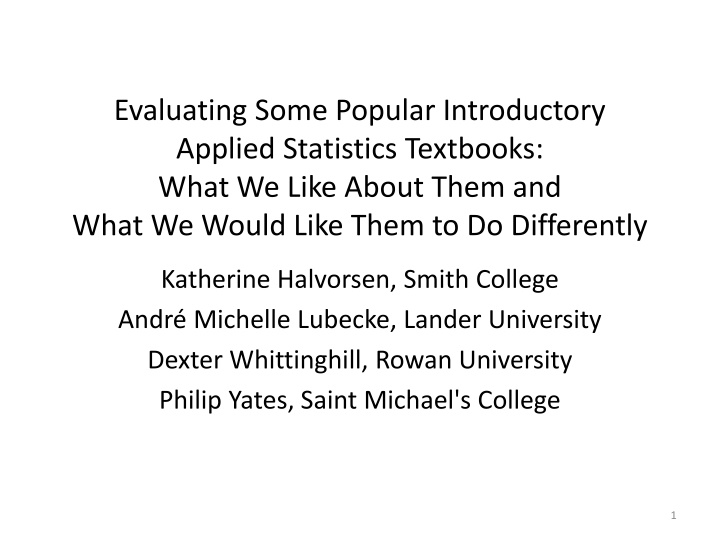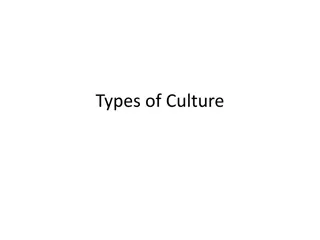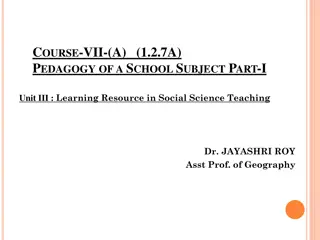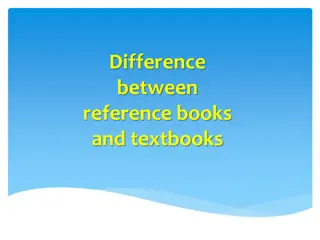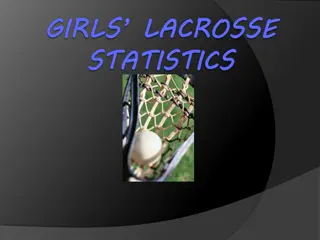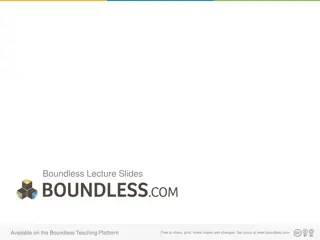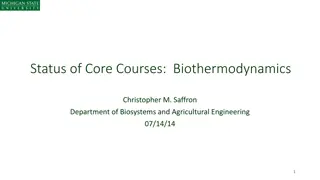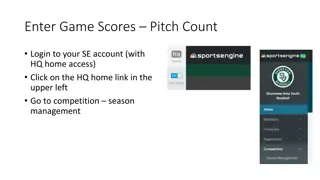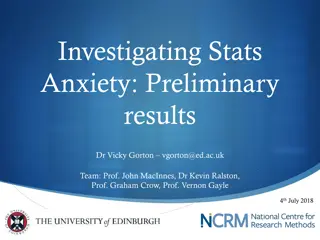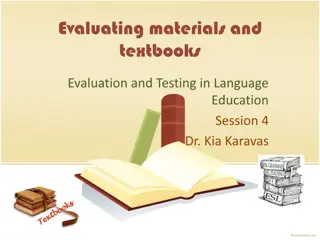Evaluating Popular Introductory Stats Textbooks: What We Like & Want Differently
Panelists review popular applied stats textbooks, highlighting likes & suggestions for improvement. Covers content, delivery techniques, and technology in detail. Engages audience for feedback and discussion to enhance future textbook editions. Key insights shared from multiple perspectives for a comprehensive evaluation.
Download Presentation

Please find below an Image/Link to download the presentation.
The content on the website is provided AS IS for your information and personal use only. It may not be sold, licensed, or shared on other websites without obtaining consent from the author.If you encounter any issues during the download, it is possible that the publisher has removed the file from their server.
You are allowed to download the files provided on this website for personal or commercial use, subject to the condition that they are used lawfully. All files are the property of their respective owners.
The content on the website is provided AS IS for your information and personal use only. It may not be sold, licensed, or shared on other websites without obtaining consent from the author.
E N D
Presentation Transcript
Evaluating Some Popular Introductory Applied Statistics Textbooks: What We Like About Them and What We Would Like Them to Do Differently Katherine Halvorsen, Smith College Andr Michelle Lubecke, Lander University Dexter Whittinghill, Rowan University Philip Yates, Saint Michael's College 1
Abstract In this session, each panelist will respond to the following two questions for two popular textbooks and their supplements: What do you like about this textbook? What would you like this textbook to do differently? To answer these questions, each panelist will present ordered lists of 10 items, two for each textbook. By these critiques of eight different textbooks, the panelists will give their opinions on all aspects of the introductory applied statistics course. Hence, they will discuss topics (content), techniques (delivery), and technology (statistical software, datasets, course management software, applets, etc.). There will be ample time for audience participation at the end of the session. Based on a past extremely popular JSM session for introductory business and economics textbooks, this session should appeal to a large number of attendees, including instructors, authors, and publishers. It should also lead to improvements in these and other introductory applied statistics textbooks, which have an extraordinary influence on how statistics is initially presented to an increasingly large number of students. 2
Likes - Katherine Halvorsen Introductory Statistics with Randomization and Simulation (1st Ed) Diez, Barr, and Mine etinkaya-Rundel(2014) 1. 2. Well written, easy to read Textbook FREE online in PDF for laptop or tablet. Paperback available for $8.49 on Amazon Examples and exercises use real data, in context Examples and exercises emphasize checking assumptions/conditions Data used in examples and exercises provided in .csv format 3. 4. 5. 3
Likes - Katherine Halvorsen Introductory Statistics with Randomization and Simulation (1st Ed) Diez, Barr, and Mine etinkaya-Rundel(2014) 6. Extensive online supplements: a) Labs for teaching R b) Lecture slides c) Supplementary text on material not in book d) Interactive apps e) Videos on statistical studies f) Teacher forums g) Sample student projects h) Course management software 4
Likes to Do Differently - Katherine Halvorsen Introductory Statistics with Randomization and Simulation (1st Ed) Diez, Barr, and Mine etinkaya-Rundel(2014) 1. Separate univariate from bivariate EDA 2. Add more discussion and exercises on types of data 3. Add more discussion and exercises on cases, variables, and values 4. Introduce correlation and regression as descriptive techniques early in text 5. Add more material on study design 5
Likes to Do Differently - Katherine Halvorsen Introductory Statistics with Randomization and Simulation (1st Ed) Diez, Barr, and Mine etinkaya-Rundel(2014) 6. Discuss study design in examples of data analyses in later chapters 7. Complete HW Answer Key (only Ch3-6 provided) 8. Number exercises in HW Answer Key with the same numbers used in text 9. Add HW exercises for probability material in appendix 10. Omit logistic regression; add more multiple regression 6
Likes - Andr Michelle Lubecke Introductory STATISTICS exploring the world through data (2nd Ed) Gould and Ryan (2016) 1. Excellent Writing: Tells the story of statistics; thoughtful ordering of topics Excellent Writing: Accessible and interesting to all levels of readers Excellent Writing: Patient mathy reminders; clear examples of incorrect statements as well as correct statements of statistical ideas Attractive: Great first impression; attractive pages Interesting examples/exercises 2. 3. 4. 5. 7
Likes - Andr Michelle Lubecke Introductory STATISTICS exploring the world through data (2nd Ed) Gould and Ryan (2016) 6. 7. Nice visuals and analogies for statistical concepts Extensive set of tools for Students: Applets, Study Cards, Video solutions to complicated problems, Guided Exercises, Chapter reviews, PowerPoint slides, E-text and online homework, One-semester text Meaningful features throughout text: Snapshot, Details, Looking Back, Key Point, Caution Reading Research Papers section 10. Excellent Instructor Resources: File of clicker questions , Notes for instructors, Index of applications by context 8. 9. 8
Likes to Do Differently - Andr Michelle Lubecke Introductory STATISTICS exploring the world through data (2nd Ed) Gould and Ryan (2016) 1. Discussion of selecting a significance level for hypothesis tests: No reasons given for why one might use value other than = .05 2. Discussion of making a decision concerning hypothesis tests: Emphasis on the rule p-value less than .05, reject 3. Prominence of the section on Reading Research Papers 4. Histogram intervals for Example 15 (Reading Electronics), Section on Comparing Means: Not the same, difficult to compare the distributions 5. Summary statistics for Example 17 (Rising College costs), Section on Comparing Means: Dependent samples BUT summary statistics are not for the differences; cannot verify given test statistic or p- value 9
Likes to Do Differently - Andr Michelle Lubecke Introductory STATISTICS exploring the world through data (2nd Ed) Gould and Ryan (2016) 6. Histogram scales in Figure 2.9 (comparing distributions): not the same 7. Grammatical error in Chapter 2: we would have got 8. Discussion of Comparing Means: Feels rushed compared to the rest of the text 9. Techniques for comparing means with independent or dependent samples: Separate into two sections 10. One-semester paperback textbook: Heavy and awkward to hold 10
Likes - Dexter Whittinghill Introduction to the Practice of Statistics (8th Ed) Moore, McCabe, and Craig (2014) 1. 2. 3. 4. 5. Modern Assumptions addressed on the spot Lots of real, interesting data sets Early descriptive regression Early normal distributions Models for regression and ANOVA 11
Likes - Dexter Whittinghill Introduction to the Practice of Statistics (8th Ed) Moore, McCabe, and Craig (2014) 6. 7. 8. 9. 10. Look Backs , Cautions & Beyond the Basics Objectives up front in section Applets Early two-way tables Arrow diagram to illustrate design 12
Likes to Do Differently - Dexter Whittinghill Introduction to the Practice of Statistics (8th Ed) Moore, McCabe, and Craig (2014) 1. Nonparametrics in the print text 2. More examples in two-way ANOVA 3. RCBD in the printed text 4. Sub-section titles lost (size/color) 5. Bring significance/P-value guidelines back 13
Likes to Do Differently - Dexter Whittinghill Introduction to the Practice of Statistics (8th Ed) Moore, McCabe, and Craig (2014) 6. 14
Likes - Philip Yates Statistics: Unlocking the Power of Data (1st Ed) Lock, Lock, Lock Morgan, Lock, and Lock (2012) 1. 2. 3. 4. 5. StatKey Bootstrapping and Randomization Tests Essential Synthesis Chapters: Review Exercises & Projects Instructor Resources: Videos Solutions & Video Tutorials Datasets 15
Likes - Philip Yates Statistics: Unlocking the Power of Data (1st Ed) Lock, Lock, Lock Morgan, Lock, and Lock (2012) 6. 7. 8. 9. 10. Just the right amount of equations Collection of Class Activities No standard normal distribution table and no t-table! Section Learning Goals at end of every section P-values: informal strengths of evidence against Ho 16
Likes to Do Differently - Philip Yates Statistics: Unlocking the Power of Data (1st Ed) Lock, Lock, Lock Morgan, Lock, and Lock (2012) 1. Include probability earlier in the book than the very last chapter Essential Synthesis sections: I would assign these as readings for outside of class CI s for proportions where s the plus 4 (AKA Agresti- Coull) method? Most of the exercises in the textbook are of the same degree of difficulty mix it up a bit? WileyPLUS adjuncts have trouble merging their courses across campuses 2. 3. 4. 5. 17
Likes to Do Differently - Philip Yates Statistics: Unlocking the Power of Data (1st Ed) Lock, Lock, Lock Morgan, Lock, and Lock (2012) 6. Multiple comparisons is an optional section I d change that Mention multicollinearity when talking about multiple regression Not enough variation, in terms of difficulty, for book exercises A few of the data sets above the heads of students: NFL Malevolent Uniforms & Penalty Yards 10. TI-83: Omit the few mentions of them 7. 8. 9. 18
Likes - Katherine Halvorsen Stats: Data and Models (4th Ed) DeVeaux, Velleman, and Bock (2016) 1. 2. 3. Well written, easy to read Humor adds interest Initial definition: stats is a way of reasoning not a course about getting the right answer Examples and exercises use real data, in context. Sidebars provide engaging pictures and real-data examples Examples follow: Think, Show, Tell pattern throughout text 4. 5. 19
Likes - Katherine Halvorsen Stats: Data and Models (4th Ed) DeVeaux, Velleman, and Bock (2016) 6. Instructor s Guide: especially the section, Importance of What You Don t Say Text has instructions for eight different software packages The Ws and one H (context) Emphasizes distinction between an empirical distribution and a probability model 10. Extensive and excellent online materials available 7. 8. 9. 20
Likes to Do Differently - Katherine Halvorsen Stats: Data and Models (4th Ed) DeVeaux, Velleman, and Bock (2016) 1. 2. 3. Cost of text is prohibitive $181 (but e-book is $99) Discuss study design earlier in the book than Ch10 Discuss study design in examples of data analyses in later chapters Introduce multiple regression as a descriptive technique earlier in the text (maybe as part of Ch 7???) Add more terms to the index (e.g., the W s ) 4. 5. 21
Likes to Do Differently - Katherine Halvorsen Stats: Data and Models (4th Ed) DeVeaux, Velleman, and Bock (2016) 6. Histogram often used to check for normality of data. Use normal scores plots as a standard part of residual analysis and for checking assumptions. Size and weight of book make it unlikely students bring it to class Success of book depends on students doing the extensive reading Include bootstrap 10. Include randomization tests 7. 8. 9. 22
Likes- Andr Michelle Lubecke Understandable Statistics Concepts and Methods (11th Ed) Brase and Brase (2015) 1. What does ________ tell us? boxes 2. LOTS of good exercises and Guided Exercises 3. Exercises labels: Statistical Literacy, Interpretation, Basic Computation, Critical Thinking, Data Highlights, Expand Your Knowledge, or subject matter 4. Quotes from historical figures: Beginning of each chapter, includes Kaplan, Nightingale, Einstein, Conan Doyle, 5. Two Gems: Old Faithful data (Bimodal after earthquake) and Robots and Welding example (Geometric distribution) 23
Likes- Andr Michelle Lubecke Understandable Statistics Concepts and Methods (11th Ed) Brase and Brase (2015) 6. Gives a good description of confounding and lurking variables Repeats definitions in later chapters when topics reoccur Sufficient material for extra topics: coefficient of variation, test of significance for r, Pearson s index for skewness Formula Reference Guide labeled by Chapter 10. Technical manuals for JMP, Excel, SPSS on Student site 7. 8. 9. 24
Likes to Do Differently - Andr Michelle Lubecke Understandable Statistics Concepts and Methods (11th Ed) Brase and Brase (2015) 1. First impression: Tables and formulas guide inside front cover 2. Writing style: Feels like Learn this word; now learn this word, especially in beginning chapters 3. Use of the interesting contexts in examples, exercises, Viewpoints for motivation 4. Attention to careful writing: A number of misleading/inaccurate statements throughout text 5. PowerPoint Slides: Entire paragraphs lifted from text and separated to form slides 25
Likes to Do Differently - Andr Michelle Lubecke Understandable Statistics Concepts and Methods (11th Ed) Brase and Brase (2015) 6. Mismatched images: Content of photos does not always match contexts presented in text Naming of the Critical Thinking Boxes: Contain definitions and key ideas; do not require critical thinking Looking Forward feature: Intended motivation may not be realized Deviations from the norm: H1, the Alternate hypothesis; n 5 for normality of sample proportions; highest/lowest values 10. Title of Chapter 10: Contains names of distributions, not topics covered 7. 8. 9. 26
Likes - Dexter Whittinghill Elementary Statistics: A Step by Step Approach (9th Ed) Bluman (2014) 1. 2. 3. 4. 5. Index of data describes them Technology bits at the end of sections Something for everybody at chapters end Extending & Applying the Concepts Significance guidelines for P-values (0.10-0.05-0.01) 27
Likes - Dexter Whittinghill Elementary Statistics: A Step by Step Approach (9th Ed) Bluman (2014) Rounding rules (for the students) 6. 7. 28
Likes to Do Differently - Dexter Whittinghill Elementary Statistics: A Step by Step Approach (8th Ed) Bluman (2014). 1. 2. 3. 4. 5. Don t try to cover everything Modernize the assumptions (i.e., 2 -indep) Normal plots should be a staple Less by-hand computation (2-way) SLR: free test of slope from test of . 29
Likes to Do Differently - Dexter Whittinghill Elementary Statistics: A Step by Step Approach (8th Ed) Bluman (2014) 6. 7. 8. 9. 10. Make combinatorics, Poisson, (Optional) More examples in two-way ANOVA RCBD in the printed text Give intuitive formulas (r, slope, intercept) Lose weighted calculations & ugly hist. boundaries 30
Likes - Philip Yates Statistics: The Art and Science of Learning from Data (3rd Ed) Agresti and Franklin (2013) 1. 2. 3. 4. 5. Activities embedded in the sections of the book Color coded graphs Logistic Regression Two Way ANOVA Nonparametric Statistics 31
Likes - Philip Yates Statistics: The Art and Science of Learning from Data (3rd Ed) Agresti and Franklin (2013) 6. 7. 8. 9. 10. Discussion of Type I and Type II errors Written in a way to teach from book out of order Datasets: General Social Survey examples The layout of examples in sections Binomial Distribution 32
Likes to Do Differently - Philip Yates Statistics: The Art and Science of Learning from Data (3rd Ed) Agresti and Franklin (2013) 1. 2. 3. 4. 5. TI-83 calculators: I d get rid of them Tables especially the random number table Breadth of topics yes, this was also in my like section! Absence of bootstrapping and randomization tests Applets only on CD-ROM or MyStatLab 33
Likes to Do Differently - Philip Yates Statistics: The Art and Science of Learning from Data (3rd Ed) Agresti and Franklin (2013) 6. 7. Combine Chapters 1 & 4 into one chapter about data CI s for proportions where s the plus 4 (AKA Agresti- Coull) method? Relative risk: I would omit this McNemar Test: I would omit this 10. Exponential Regression: I would omit this 8. 9. 34
